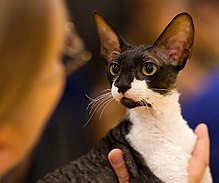Cornish Rex
| Cornish Rex | |
|---|---|
 | |
| Other names | Rex, Corny/Cornies |
| Origin | United Kingdom |
| Breed standards | |
| CFA | standard |
| FIFe | standard |
| TICA | standard |
| ACF | standard |
| ACFA/CAA | standard |
| CCA-AFC | standard |
| GCCF | standard |
| Domestic cat (Felis catus) | |
The Cornish Rex is a
Characteristics
The coat of a Cornish Rex is extremely fine and naturally curly.[2] Their light coat means that they are best suited for indoor living in warm and dry conditions, as they are sensitive to low temperatures.[citation needed]
The breed is sometimes referred to as the
Appearance
According to the Governing Council of the Cat Fancy (GCCF) standard, the Cornish Rex's colour is irrelevant[2] — therefore the cat may be any colour.[4]
Aside from the distinctive the coat, the Cornish Rex is set apart by its 'foreign type', slender legs and tail, oval eyes, and wedge shaped head.[2] The Cornish Rex's ears are large and wide at the base with rounded tips and are described as being almost mussel shell shaped. The eyes are medium in size and come in all varieties of eye colour. The body is slender and muscular with small paws.[2]
Genetics
In 2013, researchers identified the mutation that defines the Cornish Rex breed. Genome-wide analyses were performed in the Cornish Rex breed and in 11 phenotypically diverse breeds and two random bred populations. A gene on chromosome A1, the lysophosphatidic acid receptor 6 (
Origin
The Cornish Rex is a
The Devon Rex looks similar in appearance to the Cornish Rex but has guard hairs and sheds. The Devon Rex mutation is different from the Cornish Rex mutation in that the Devon has shortened guard hairs, while the Cornish Rex lacks guard hairs altogether.[8]

Hypoallergenic
Despite some belief to the contrary, the Cornish Rex's short hair does not make it non- or
References
- ^ a b Drummey, Kristen (20 July 2022). "What to Know About a Cornish Rex". WebMD. Retrieved 15 August 2023.
- ^ a b c d "Cornish Rex Standard" (PDF). Governing Council of the Cat Fancy. Retrieved 20 February 2024.
- ^ Animal Planet television series: "Cats 101" episode:"Colorpoint Shorthair".
- ^ "Cornish Rex". Governing Council of the Cat Fancy. Retrieved 20 February 2024.
- PMID 23826204.
- .
- ^ "A New Look In Cats". The Observer. 31 January 1965. pp. 4–5.
- ISSN 1573-6857.
- PMID 34622710.
External links
- Cornish Rex Club of Canada - Cornish Rex cat breed association that promotes and protects the breed in Canada.
